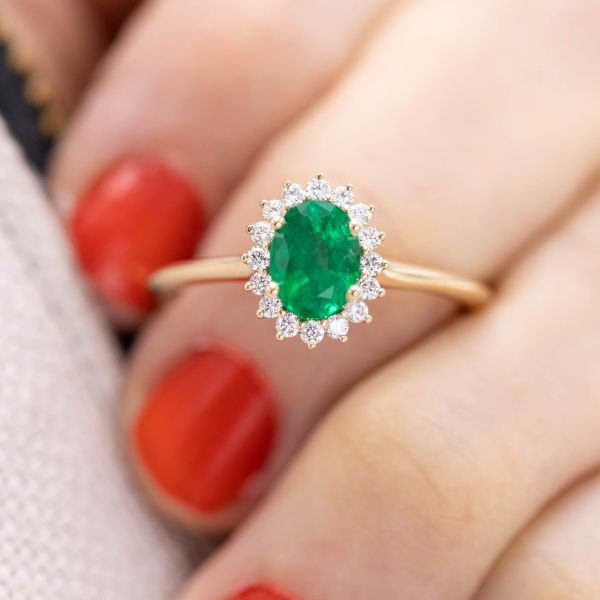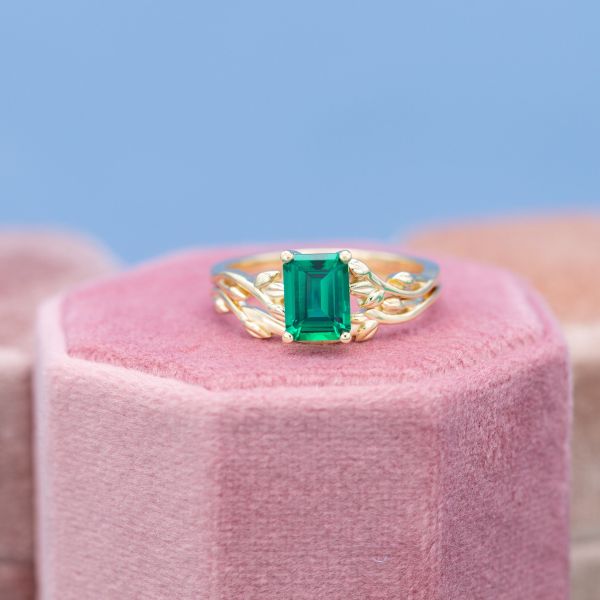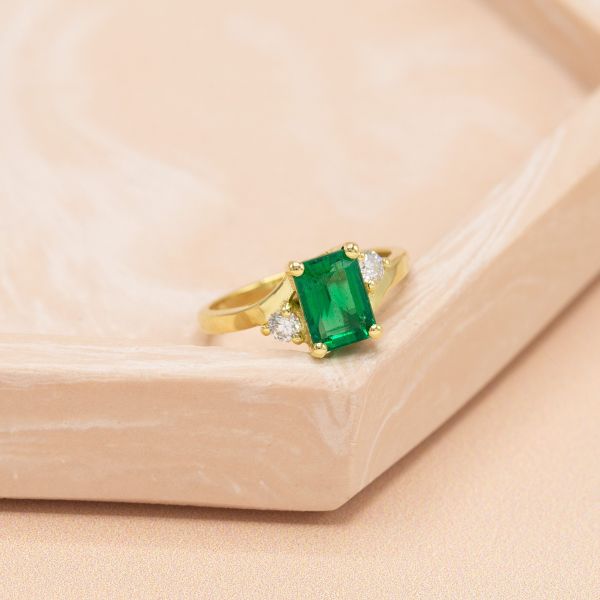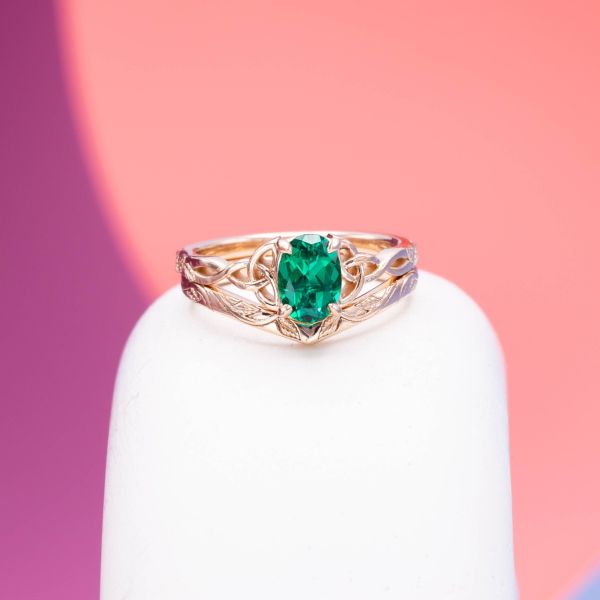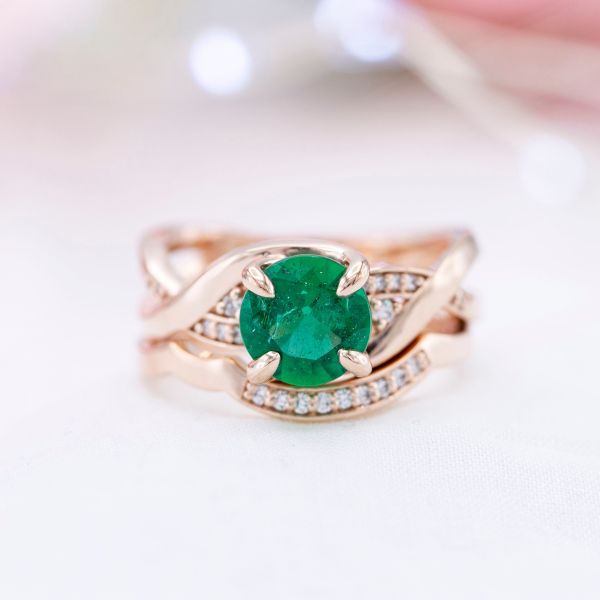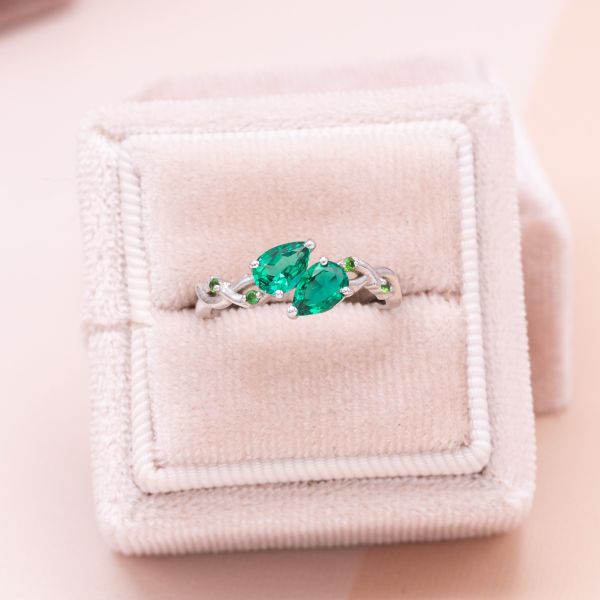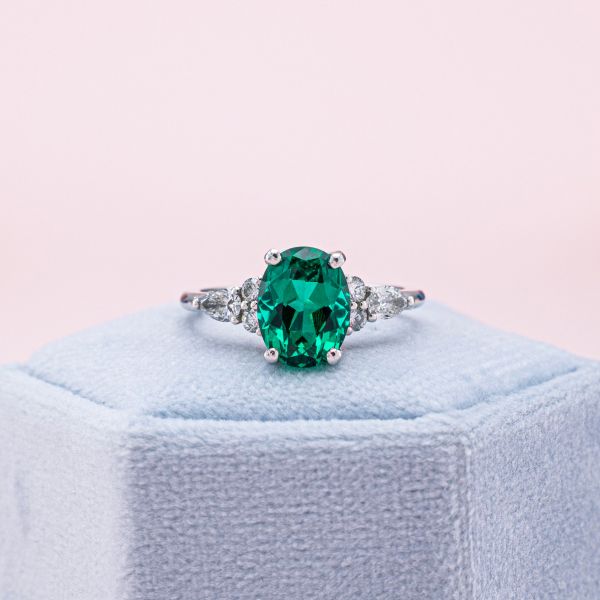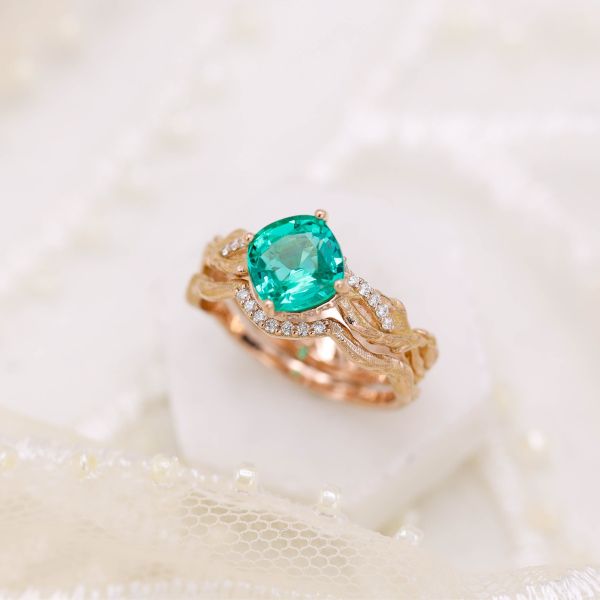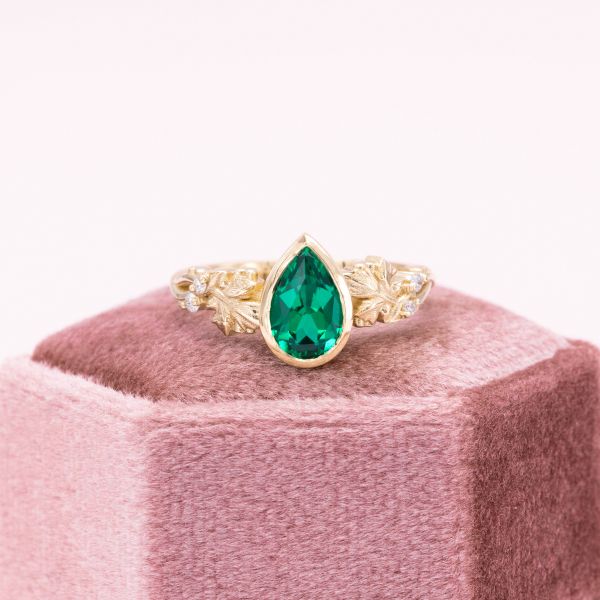Gemstone Knowledge
Lab vs. natural emeralds
Do lab emeralds stack up to the reputation of natural stones?
Is a lab emerald a real emerald?
If you’re looking for a green stone for your engagement ring, you may have stumbled upon lab emeralds in the process. It’s fair to wonder whether lab emeralds can live up to the natural version of this gemstone, and while they do have their differences (more on that shortly) both versions are actually chemically the same! Whoever said lab created stones weren’t “real” gemstones was dead wrong. Just like lab diamonds are real diamonds, lab emeralds are real emeralds, but that doesn’t mean they don’t have some differences.
Lab lovers (the stone, not the pup!) will often say they’re die-hards for lab emeralds because they lack jardin–or internal fractures. Jardin makes natural stones less durable for regular wear and often appears like veins running through the stone. Lab emeralds don’t have to worry about these veins so they can be top color and clarity with less durability concerns at a fraction of the price of their natural counterparts.
On the other hand, those who are nuts about natural emeralds will tell you that jardin is a pivotal part of an emerald’s appeal, creating subtle color variations that you don’t find in lab stones. They might also argue that lab emeralds can be picked out of a lineup easily with their standardized color and flawless clarity, which takes away from the uniqueness that many couples seek from an emerald in the first place.
So, where do you fall in this debate? Need more info to figure out whether a lab or natural emerald is right for your needs? Don’t worry, we’ve got you covered with a rundown of all the major differences between natural and lab emeralds so you can make an informed decision regarding your own engagement stone!
Comparing lab and natural emeralds
Origin
Both lab and natural emeralds are beryls (chemically the same, remember) but the main difference is how each version forms. In fact, natural emeralds are considered extremely unusual and improbable in the gemological world, which is part of the reason they're so prized by those loyal to natural stones. Seriously, think of finding a snowman in the desert—that’s how strange it is that all of the elements needed to form an emerald came together! Emeralds combine elements from completely different depths within the earth, so there are only a few places they can form naturally.
Beryllium—a main ingredient in beryl—is a light element found near Earth’s crust, but it combines with much heavier chromium and vanadium from near Earth’s core to produce emeralds. To bring these elements together, hydrothermal waters or magma filled with the heavier components must meet rocks from Earth’s crust and get hot enough to form beryl. Natural emeralds primarily come from South America and Africa with some gorgeous specimens found in places like Colombia, Zambia, Brazil, and Ethiopia. Look at that; a little science and geography thrown together into one emerald lesson!
Some emeralds have particular inclusions that can let professionals know where they were mined! The environments are so specific that they produce patterns or inclusions unique to that region.
Lab emeralds are, of course, made in a lab, but how exactly do they come to be? There are two main methods experts use to create lab emeralds: flux and hydrothermal processes. Flux-grown emeralds require a high heat and a flux material (a solvent or purifying agent) to dissolve already formed emeralds into a solution where all of their main ingredients are present. Then, experts lower the temperature to just below the crystallization point so new emerald crystals can form.
For the hydrothermal process, on the other hand, experts combine emerald components with water and pressure cook them at high temperatures around a seed crystal to form emeralds. Because they’re made in a lab environment in much less time, lab emeralds are more efficient and cost significantly less than their natural counterparts (but more on that later!) for budget-friendly beauty and quality.
Appearance
Another way lab and natural emeralds differ is in their appearance. But wait, if they’re made of the same elements, how can they look different? Like we mentioned earlier, natural emeralds form without any intervention, so there’s a bit more color variation and uniqueness to these green beauties. “Top color” for natural emeralds is a rich green hue with strong saturation, a medium to medium-dark tone, and subtle blue undertones that produce a blue-green coloration. While this is the color that most couples seek when looking for emeralds, variations in saturation and tone can create different takes on that green color–such as Granny Smith apple, mint, or even a lively spring green–that really amplify the stone’s uniqueness.
Natural emeralds also have jardin, which are silky inclusions that give these green stones a dreamy look when visible like we mentioned before. Jardin isn’t always noticeable to the naked eye, but when they are they make each emerald distinctive as, much like fingerprints, no two stones have the same pattern. As a result, some couples absolutely love the one-of-a-kind look jardin can provide, but others stick to emeralds with high-quality clarity to avoid noticeable inclusions.
That’s where lab emeralds come in! At CustomMade, we focus on lab emeralds that are crafted to have top color, so they offer that same signature blue-green hue you’d find in high-quality natural stones. In addition, lab emeralds have high clarity with no jardin, so they’re a great choice for couples who want that “perfectly clean” look without any threadlike inclusions. As such, there’s much less need to worry about quality when it comes to lab emeralds, as they’re often designed to be flawless in a way that would be much harder to find in natural stones.
If top color is your aim while searching for an emerald, you may want to consider lab emeralds to save yourself some time and money. Or, if you’re entranced by the distinctive appeal of natural emeralds or want one of those lesser-seen color variations, our team at CustomMade can source stones for you to view
Durability
Ringing in at a 7.5 to 8 on the Mohs scale of hardness, both lab and natural emeralds are suitable for daily wear, but lab emeralds do offer an advantage when it comes to durability. A key point to keep in mind is that both natural and lab emeralds have good hardness, meaning they won’t easily scratch, but lab emeralds are stronger when it comes to toughness, so they’re less likely to chip or crack.
Remember that jardin we’ve mentioned a few times already? It turns out these inclusions leave natural emeralds prone to breakage, so a hard enough hit could potentially fracture a natural stone. To help remedy this, most natural emeralds receive oil or resin treatments to make them a bit more durable. Since lab emeralds don’t contain jardin, their enhanced fracture resistance helps them better withstand daily wear.
So what does this mean? For those of us uncoordinated people who are all thumbs, having the additional durability a lab emerald provides can be a saving grace. But, if you’re committed to caring for a natural emerald and don’t mind replacing those oil or resin treatments over time, then a natural stone may be the one for you!
Price
If finances are on your mind, you’ll likely be interested in the price difference between natural and lab emeralds. Natural emeralds are rare—especially at larger sizes and higher quality grades—and so their prices reflect this stone’s exclusive nature. For a 1 carat natural emerald of recommended quality, couples can expect to pay anywhere between $1,750 and $4,000. From there, prices jump at the 2, 3, 5, 8, and 10 carat mark.
In contrast, lab emeralds are actually rather affordable, coming in at about $625-$675 for a stone of equal quality to the natural emerald described above. That’s less than half the price of a natural stone in some cases, leaving plenty of wiggle room in your budget for a larger center stone, more accent stones, a platinum setting, or even putting that money back into your ceremony and reception. You could even invite the entire CustomMade team to your wedding (pretty please)! Whether we receive an invite to your big day or not, we can agree that these price differences are pretty stark. That being said, there’s no right or wrong answer here: it really comes down to which stone you love the look of and what fits your budget!
Lab or natural emerald?
The choice between natural and lab emerald is a personal one, and it all comes down to what you require from your center stone. Are you in love with that classic natural emerald look and don’t mind the extra care and higher price point? Or, are you looking for an emerald that’s a good balance of quality and value and don’t really care if it was made in a lab? All of these factors should be considered when choosing an emerald for your engagement ring, and our team is here to help! Contact us today to learn more about selecting the right emerald for you.
About CustomMade
CustomMade designs and creates one-of-a-kind, custom engagement rings and fine jewelry. Each piece we create is inspired by you, designed for you, and made just for you.

